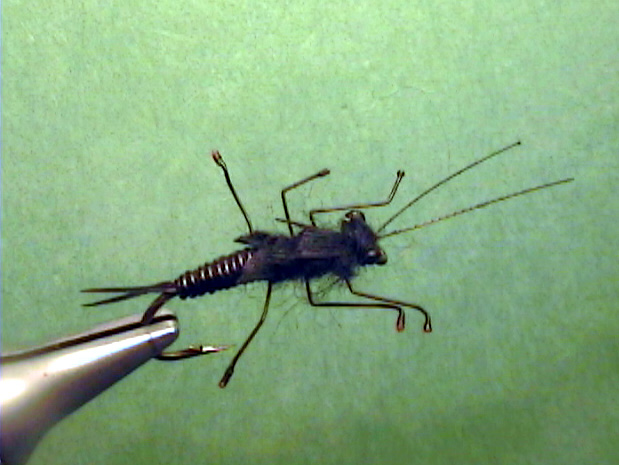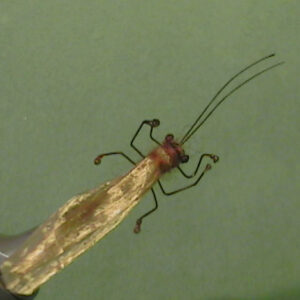Hook Size: 4/6
The Perfect Fly Giant Black Stonefly nymphs crawl out of the water to hatch in the mid to early afternoons and on into the evening. The hatch into adults on the banks or rocks out of the water. You should fish the fly near the banks while they are hatching.
About the only clue you will have that the Giant Stoneflies are hatching is finding
a shuck or empty skin of the nymph left to dry when one of the large stoneflies
changed from a nymph to an adult or fully grown fly. When you start seeing
shucks on the rocks and banks of the stream you can be assured the Giants
have started to hatch. Unless you search the high limbs of trees or search the
sky early in the mornings or near dark, it is rare you will spot an adult.
Nymph Presentation:
These nymphs stay down between and under rocks most of the time. They do
come out to eat and to hatch, of course. One interesting thing about them is
that they are available in three sizes at any one time. They live for three years.
That means there are one year old nymphs available, two year old ones and
three year old ones that are available for the trout to eat.
There are two basic ways to fish imitations of the nymph as far as I am
concerned. One is the “high stickin” method. It works in fast water runs and
riffles. In case you are not familiar, you stand perpendicular to a run just beyond
a rods length from it. This works best when the water in the run is at least two or
three feet deep. Approach the run very carefully to avoid alerting the trout of
your presence. Make an up and across very short cast. You only need two to six
feet of line out the tip of your rod and a eight or nine foot leader. In this case, I
would recommend a 4X or even larger 3X or 2X leader. You want to weight the
tippet about eight inches above the fly with enough weight to get it down on the
bottom fast. This will vary with the depth of the water and the speed of the
current. Swing the rod downstream directly above the fly keeping the fly on or
very near the bottom. Straighten your rod arm and keep it high. If the fly stops,
or you feel a “live” thump, set the hook. When the fly is downstream of your
position, make another cast. To cover new water, you can cast a little farther
over in the run or you can move upstream a step before making the next cast.
The other method I use is intended to imitate the nymphs migrating to the banks
to hatch. When enough of these nymphs start moving to the banks to hatch, the
trout will begin to intercept them close to the banks. Use this method during the
hatch in low light situations either very early in the mornings or late in the day.
Stand on the bank a few feet from the water so that you will not spook any trout
near the bank. Cast up and across the stream. Use a heavily weighted fly and
keep it on the bottom. Bring the fly back to the bank using continuous short two
to three inch retrieves. Use the fingers of your non-rod hand to make the short
retrieves. Bring the fly all the way to the bank even if the fly is almost directly
downstream from your position. Follow the drift of the fly downstream with your
rod. You want have any problem detecting the bite. This only works where the
banks are clear enough of trees and other obstructions to do this. You will need
to be creative in bringing the fly towards the banks in other situations. By the
way, both of these methods are very effective for catching large brown trout.
Copyright 2013 James Marsh

